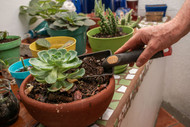From Novice to Expert: How to Cultivate and Maintain a Stunning Indoor Succulent Collection
Sep 12th 2024
Estimated reading time: 8 minutes
Enhancing your home environment with a collection of indoor succulents is achievable for both beginners and seasoned indoor gardening enthusiasts alike! These sturdy plants that are famous for their adaptability to environments need precise but simple nurturing methods to grow well, from knowing the lighting conditions for succulents to becoming adept at watering them correctly. Every stage in caring for succulents is crucial for cultivating a lively and thriving succulent garden. Here’s a helpful guide to taking care of your succulents! Learn about potting techniques and how to care for your plants to keep them looking beautiful and peaceful in your space. Try Arizona Flower Market for top-notch succulents and professional guidance to make your indoor gardening experience more fulfilling.
Table of contents
- Essential Succulent Care Tips
- Building Your Succulent Garden
- Advanced Plant Care for Succulents
- Succulent Care FAQs: Expert Answers for Thriving Indoor Plants
Essential Succulent Care Tips
Optimal Lighting for Succulents
Succulents need plenty of sunlight to grow and stay vibrant successfully in their environment; they typically enjoy 6 to 12 hours of continuous sunlight daily. To replicate this condition indoors for your succulent well-being and color preservation, position them on a windowsill or near a western-facing window to ensure they receive ample daylight exposure. If space or natural light is scarce in your home setting, using a grow light is a solution to support the health and vibrant appearance of your plants. Indications that your succulents aren’t getting light include them reaching towards the light source and having long stems, with leaves falling off while the soil stays consistently dampened. You might have to change where they are placed or improve the lighting conditions to help them thrive and look beautiful in your garden.
Proper Watering Routines
Watering succulents correctly is crucial for their survival and growth. These plants originate from arid regions where water is scarce, so overwatering is a common mistake. Allow the soil to dry completely between waterings, mimicking the sporadic rainfalls of their native habitats. When it’s time to water, soak the soil thoroughly until water drains from the pot’s bottom. Ensure any excess water is removed from the saucer to prevent root rot. This method prevents the waterlogged conditions that succulents dislike. In winter, when growth slows, reduce watering to once every 4-6 weeks. During this dormant period, succulents require less moisture, aligning with their natural cycle. Recognizing signs of improper watering, like wrinkled leaves indicating dehydration or yellow, soggy leaves from excess water, helps you adjust your routine effectively. With these practices, your succulents will remain healthy and robust, adding to the beauty of your indoor garden.
Effective Potting Methods
Choosing the right potting method is fundamental to the health of your indoor succulents. The pot must have adequate drainage to prevent water accumulation, which can lead to root rot. Clay or terracotta pots are ideal as they wick away excess moisture, keeping the soil from becoming too damp. When selecting a potting mix, opt for one that is well-draining, often containing components like perlite or pumice. These materials help prevent compacted soil and ensure quick water drainage. Repotting succulents when they outgrow their containers or when the soil becomes compacted is crucial for their vitality. Handle these resilient plants carefully, especially those with spines or needles, to avoid damage. Additionally, during repotting, inspect the roots for signs of overcrowding or rot and trim as necessary. By adhering to these potting practices, your succulents will flourish, contributing to a thriving indoor succulent garden.
Building Your Succulent Garden
Selecting Resilient Plants
When building your indoor succulent garden, selecting resilient plants is key to ensuring a low-maintenance and thriving collection. Consider the natural habitat of succulents, which equips them with the ability to store water and withstand drought conditions. Opt for species known for their adaptability, such as the Snake Plant or ZZ Plant, which tolerate lower light levels typical of indoor environments. For those with more sunlight available, colorful varieties like the Hedgehog Aloe or Ponytail Palm flourish with direct exposure. Assess your living space’s light conditions and choose plants accordingly for optimal growth. Additionally, consider mixing green and colorful succulents to create visual interest. By selecting species that align with your environment’s lighting and space, you lay the foundation for a robust and beautiful succulent garden. This thoughtful selection process ensures your plants will not only survive but thrive, enhancing your indoor space with their unique beauty and resilience.
Arranging for Aesthetic Appeal
Arranging your succulents for aesthetic appeal involves a blend of creativity and practicality, enhancing the visual harmony within your indoor space. Start by considering the color, texture, and size of each plant. Grouping succulents with complementary hues or contrasting textures can create visual interest and a dynamic display. Layering plants of varying heights adds depth, drawing the eye through different focal points. Use shallow containers or trays to display multiple succulents together, which not only saves space but also creates a lush, unified appearance. Consider the role of decorative elements such as pebbles or small stones, which can add contrast and help define individual plants. When arranging, ensure each plant has adequate space and access to light, maintaining their health and vibrancy. This thoughtful arrangement not only showcases the unique attributes of each succulent but also elevates the overall aesthetic of your indoor garden, transforming your living area into a serene, natural oasis.
Maintaining a Thriving Collection
Regular monitoring and care are essential to maintaining a thriving succulent collection. Start by observing your plants’ growth patterns and adjusting care routines as needed. Ensure they receive adequate light, as insufficient lighting can lead to etiolation, where plants stretch and lose their compact form. Watering should be adjusted seasonally, with more frequent watering during growth periods and reduced frequency during dormancy. Regularly check for signs of pests or diseases, such as discolored leaves or unusual spots, and address these issues promptly. Cleaning the leaves periodically helps prevent dust accumulation, which can hinder photosynthesis. Additionally, dead or wilting leaves should be removed to promote new growth and maintain the collection’s overall health. By staying attentive and responsive to your succulents’ needs, you can enjoy a vibrant, lush indoor garden. This ongoing care not only ensures their longevity but also keeps your space filled with the beauty and tranquility that a well-maintained succulent collection offers.
Advanced Plant Care for Succulents
Addressing Common Issues
Even with the best care, succulent enthusiasts may encounter common issues that require attention. One frequent problem is overwatering, which can lead to root rot and yellowing leaves. To address this, ensure your pots have proper drainage and adjust your watering schedule to allow soil to dry completely between waterings. If succulents exhibit stretched growth, they may need more light. Relocate them to a brighter spot or consider supplemental lighting. Leaves turning brown or scorched could indicate too much direct sunlight, in which case relocating to a location with indirect light may help. Pest infestations, such as aphids or mealybugs, can be treated with insecticidal soap or neem oil. Removing and isolating affected plants can prevent the spread. Regularly inspecting your succulents allows for early detection and management of these issues, ensuring your collection remains healthy and vibrant, enhancing your indoor environment with its resilient beauty.
Seasonal Maintenance Strategies
Maintaining a thriving succulent collection requires adapting your care routine to seasonal changes. During the growing months of spring and summer, succulents require more frequent watering and can benefit from occasional fertilization with a diluted balanced fertilizer. As daylight increases, ensure they receive ample sunlight by possibly relocating to brighter spots or using grow lights to supplement natural light. In contrast, fall and winter bring dormancy for most succulents, necessitating reduced watering—often only once every 4-6 weeks. It’s crucial to adjust the watering frequency to prevent root rot during this period of reduced growth. Additionally, keep an eye on temperature changes, as succulents prefer cooler, but not freezing, conditions in winter. Ensuring they are not exposed to drafts or temperatures below their tolerance can prevent cold damage. By aligning your care practices with the seasonal needs of your succulents, you support their health and vitality throughout the year, maintaining a vibrant indoor garden.
Enhancing Growth and Color
To enhance the growth and color of your succulents, focus on optimizing their growing conditions. Adequate lighting is paramount; place succulents where they receive plenty of bright, indirect sunlight to maintain vivid coloration and compact growth. If natural light is insufficient, especially during winter months, consider using full-spectrum grow lights to mimic sunlight. Nutrient management also plays a role in enhancing growth. Although succulents typically thrive in nutrient-poor soil, a light application of a balanced, diluted fertilizer during the growing season can boost their vitality and color. Regular pruning of dead or leggy growth encourages new, healthy development, maintaining the plant’s aesthetic appeal. Additionally, keeping the foliage clean from dust allows for better light absorption, contributing to vibrant colors. By fine-tuning these elements, you can maximize the natural beauty of your succulents, ensuring they remain a striking and colorful feature of your indoor garden.
Succulent Care FAQs: Expert Answers for Thriving Indoor Plants
How much light do indoor succulents need?
Indoor succulents thrive on 6-12 hours of sunlight daily. Place them near a south or west-facing window for optimal lighting. If natural light is limited, consider using grow lights to supplement.
How often should I water my succulents?
Allow the soil to dry completely between waterings. Water thoroughly until it drains from the bottom of the pot, then remove excess water. In winter, reduce watering to once every 4-6 weeks due to slower growth.
What type of pot and soil are best for succulents?
Use pots with good drainage holes, preferably clay or terracotta as they wick away excess moisture. Choose a well-draining potting mix containing components like perlite or pumice to prevent soil compaction.
How can I tell if my succulent isn’t getting enough light?
Signs of insufficient light include stretching toward light sources, elongated stems, leaf drops, and persistently moist soil. If you notice these signs, consider relocating your plant or using supplemental lighting.
How do I maintain my succulent’s vibrant colors?
Ensure adequate bright, indirect sunlight. During growing seasons, apply a light, diluted balanced fertilizer. Keep foliage clean from dust to improve light absorption. Proper light exposure is key to maintaining vivid colors in succulents.



